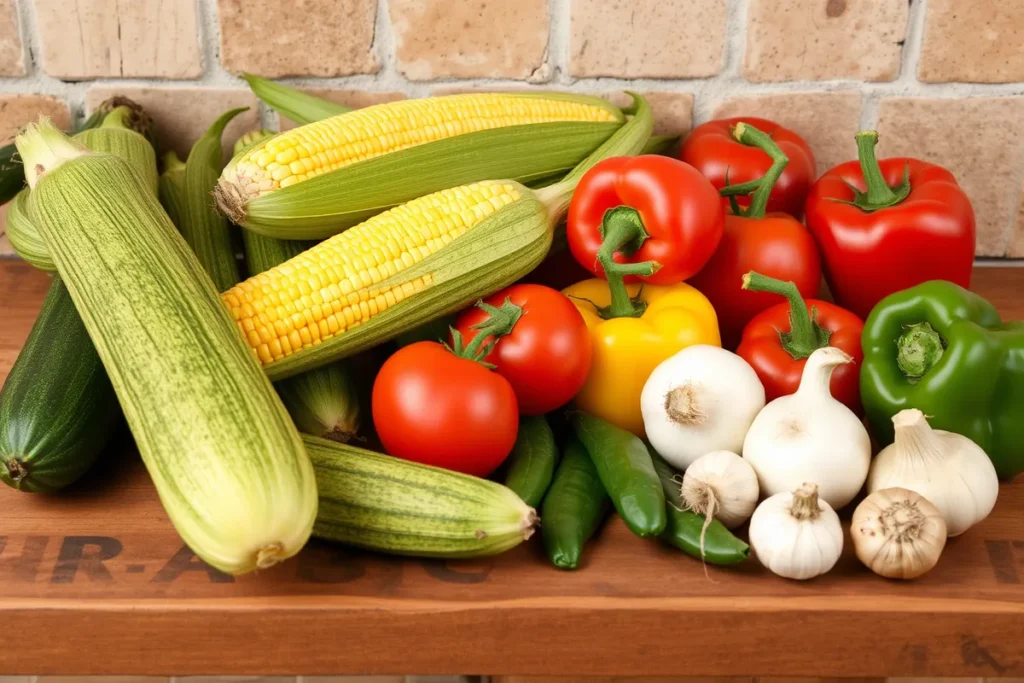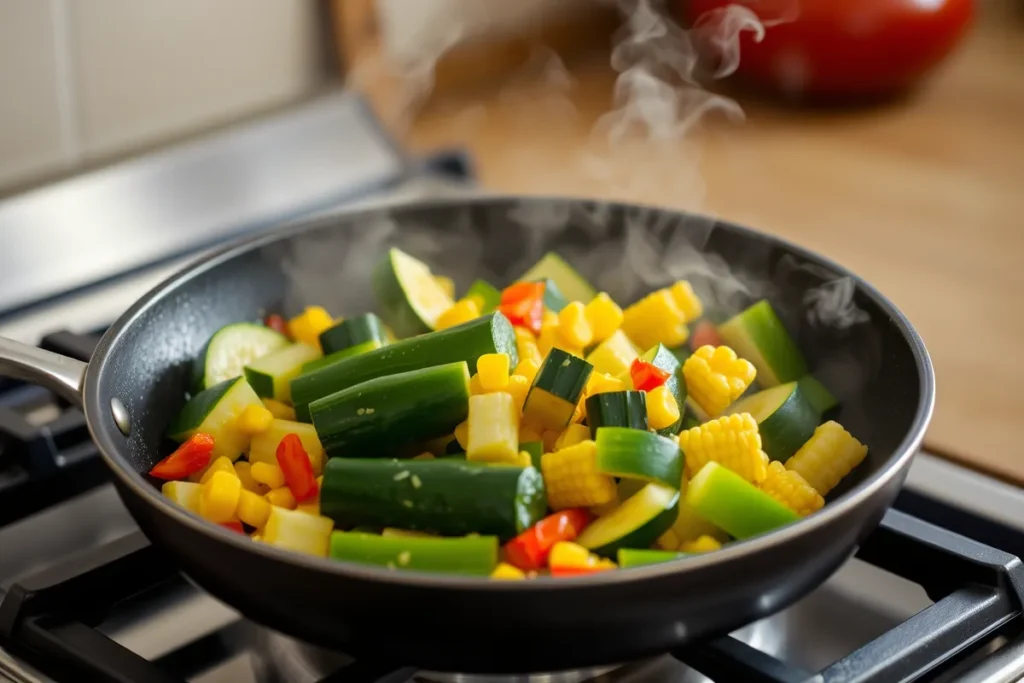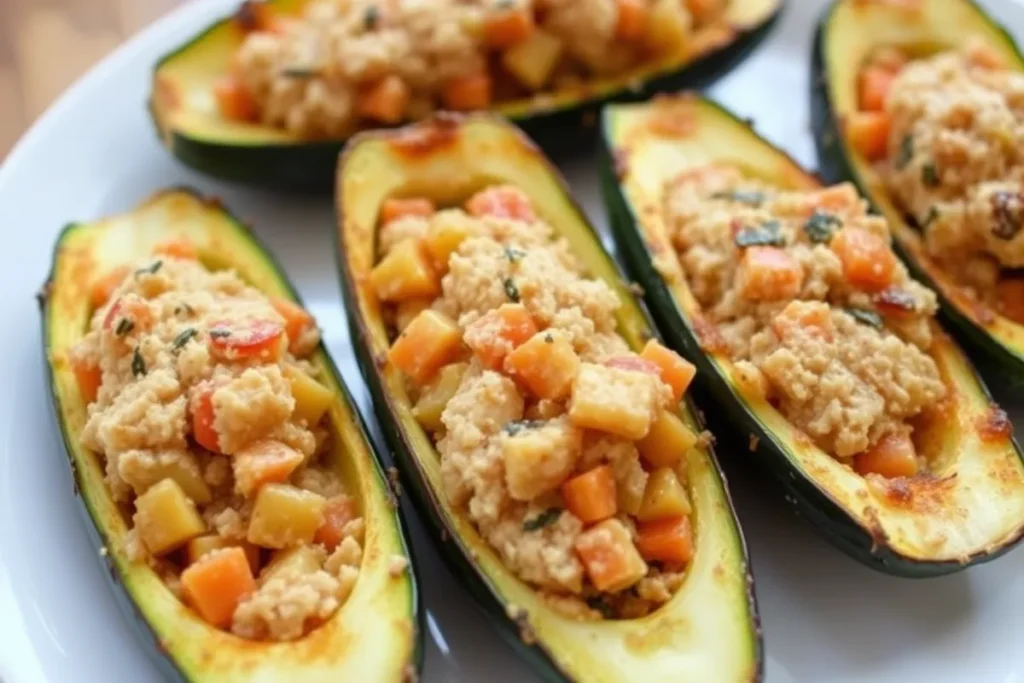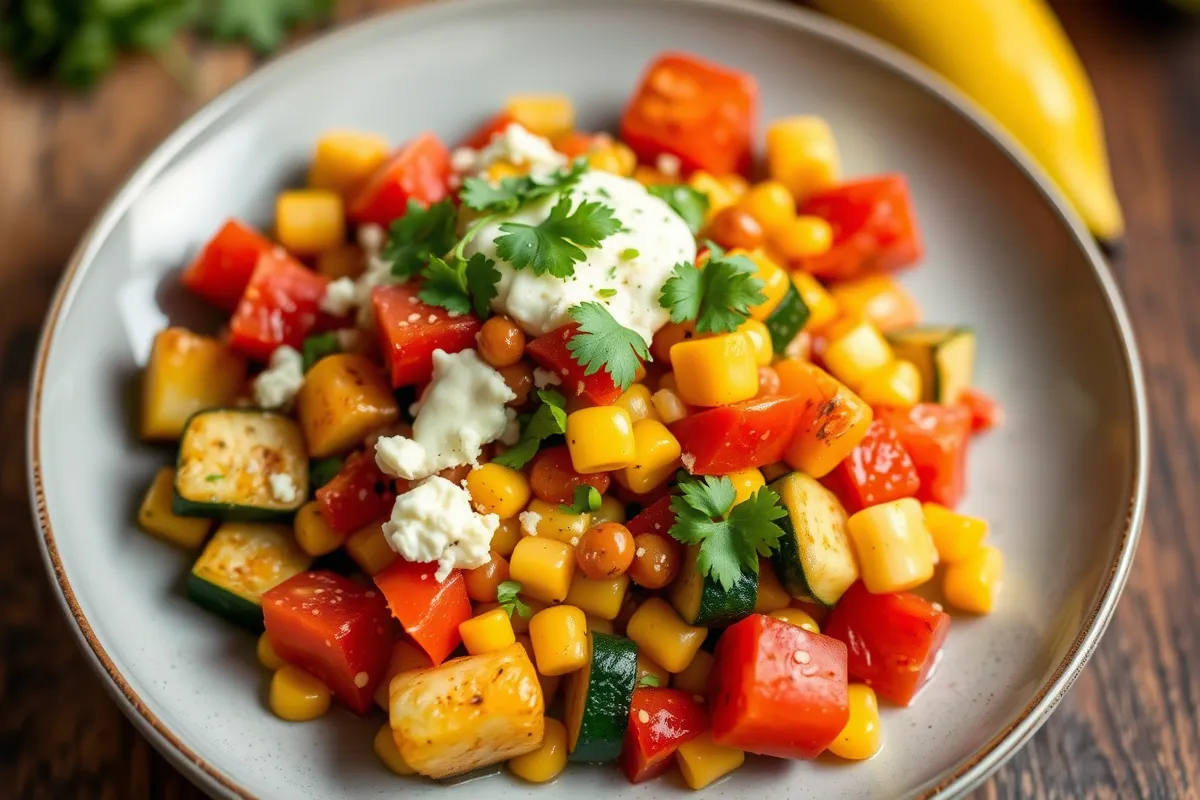When it comes to celebrating the heart of Mexican cuisine, calabacitas shines as a wholesome, versatile, and easy-to-make dish. Rooted in the traditions of Mesoamerican cooking, it combines fresh vegetables with bold, earthy flavors. Whether you’re new to calabacitas or a seasoned cook looking for tips to perfect it, this guide covers everything from its history and ingredients to preparation and serving ideas. Let’s explore the essence of this beloved dish, starting with what makes calabacitas so special.
Introduction to Calabacitas
What Are Calabacitas?

Calabacitas—literally translating to “little squash” in Spanish—is a traditional Mexican dish known for its vibrant and fresh ingredients. It’s typically prepared with zucchini or Mexican squash, paired with sweet corn, ripe tomatoes, and peppers for a dish that’s bursting with flavor. Often served as a side or a light main course, calabacitas is a testament to the beauty of simple, seasonal cooking.
This dish holds universal appeal, not just for its taste but also for its nutritional value. Packed with vitamins, fiber, and antioxidants, it’s a hearty meal for vegetarians and omnivores alike. Many households enjoy it with a sprinkling of cheese for added richness, but it’s just as delicious in a vegan version.
Historical Background
The roots of calabacitas go deep, tracing back to the indigenous Mesoamerican diet where squash, corn, and beans were staples—collectively known as the “Three Sisters.” These crops were cultivated together, symbolizing harmony and sustenance. Over time, this trio inspired dishes like calabacitas, embodying a fusion of indigenous ingredients and cooking techniques with Spanish influences.
Today, the dish is celebrated not only in Mexican households but also across the Southwestern United States. It has become a favorite for those looking to connect with their heritage through food while enjoying something healthy and flavorful.
Cultural Significance in Mexican Cuisine
For many, calabacitas is more than just a dish—it’s a tradition. Often prepared during harvest season, when squash and corn are at their peak, it serves as a reminder of the connection between food and the land. Families pass down recipes from generation to generation, tweaking them to suit regional preferences and local ingredients.
From comforting weeknight meals to festive gatherings, plays a vital role in Mexican culinary culture. The adaptability of the dish, whether as a vegetarian option or paired with proteins like chicken or shrimp, makes it a staple in diverse kitchens.
Ingredients and Nutritional Profile
Key Ingredients in Calabacitas
The magic of calabacitas lies in its simplicity, relying on fresh, wholesome ingredients that are easy to find and bursting with flavor. Here’s a closer look at what makes this dish a standout:
- Zucchini or Mexican Squash: The star of the show, zucchini offers a tender texture and mild flavor. Mexican squash is an excellent alternative, with a slightly sweeter taste and firmer texture.
- Corn: Sweet and slightly crunchy, corn brings balance and vibrancy to the dish. Fresh kernels are preferred, but frozen or canned work well too.
- Tomatoes: Juicy, ripe tomatoes add a subtle tanginess and help create a rich, flavorful base.
- Peppers: From mild poblanos to spicy jalapeños, peppers provide depth and optional heat to the dish.
- Onions and Garlic: Essential aromatics that enhance the savory profile, making every bite irresistible.
- Cheese: Commonly Queso Fresco or Monterey Jack, cheese melts beautifully into the dish, adding creaminess and richness. For a vegan twist, plant-based cheese or nutritional yeast can work wonders.
Nutritional Benefits
It’s no surprise that calabacitas is a popular choice for health-conscious cooks. This dish is packed with nutrients, making it as wholesome as it is delicious.
- Vitamin Powerhouse: Zucchini and tomatoes are loaded with vitamins A and C, supporting immune health and glowing skin.
- High in Fiber: With corn and squash at its core, calabacitas supports digestion and promotes a feeling of fullness.
- Low in Calories: This dish is naturally low in calories, making it perfect for those watching their intake without sacrificing flavor.
- Rich in Antioxidants: Tomatoes and peppers are bursting with antioxidants like lycopene, which protect against cell damage and inflammation.
Calorie Count and Macronutrient Breakdown
On average, a one-cup serving of calabacitas contains:
- Calories: Approximately 90–120, depending on ingredients like cheese or oil.
- Protein: About 4–6 grams from the vegetables and added cheese.
- Carbs: Roughly 12–15 grams, mainly from corn and squash.
- Fats: Around 5 grams, especially if cheese or oil is included.
This makes it a versatile dish suitable for various dietary needs, from low-carb to vegetarian lifestyles.
Preparation and Cooking Methods
Traditional Calabacitas Recipe

Preparing calabacitas is as simple as it is rewarding. This traditional recipe highlights the classic ingredients and techniques that have made the dish a staple for generations.
- Ingredients Needed:
- 2 medium zucchini or Mexican squash, diced
- 1 cup fresh or frozen corn kernels
- 2 medium tomatoes, diced
- 1 medium onion, chopped
- 1–2 cloves garlic, minced
- 1 poblano or jalapeño pepper, diced (optional for heat)
- 1 cup shredded cheese (Queso Fresco or Monterey Jack recommended)
- 1–2 tablespoons vegetable oil
- Salt and pepper to taste
- Fresh cilantro for garnish
- Step-by-Step Instructions:
- Heat the vegetable oil in a large skillet over medium heat. Add the onion and garlic, sautéing until fragrant and translucent.
- Stir in the diced zucchini and peppers. Cook for 5–7 minutes until the zucchini is tender but not mushy.
- Add the corn and tomatoes, mixing well. Let the mixture simmer for an additional 5 minutes.
- Season with salt and pepper to taste, then sprinkle the shredded cheese on top. Cover the skillet and allow the cheese to melt.
- Garnish with fresh cilantro before serving.
Variations of Calabacitas

One of the best things about calabacitas is its adaptability. Whether you prefer a spicy kick or a heartier version, there’s a variation for everyone.
- Protein Boost: Add cooked chicken, ground beef, or shrimp for a more substantial meal.
- Vegan Version: Replace cheese with plant-based alternatives or nutritional yeast for a dairy-free dish.
- Extra Veggies: Incorporate bell peppers, spinach, or mushrooms for added color and nutrients.
- Stuffed Calabacitas: Hollow out zucchini or squash and stuff them with the calabacitas mixture, then bake for an elegant presentation.
Tips for Perfecting Calabacitas
Creating the perfect calabacitas involves attention to detail and a few tricks:
- Use the freshest vegetables available for the best flavor and texture.
- Avoid overcooking the zucchini; it should be tender but not mushy.
- Adjust seasoning gradually, tasting as you go to ensure the flavors are balanced.
- To make the dish lighter, sauté vegetables with minimal oil and skip the cheese.
Serving Suggestions and Pairings
Serving Calabacitas as a Side Dish

Calabacitas is a versatile side dish that pairs beautifully with a variety of main courses. Its vibrant flavors and hearty texture complement both traditional Mexican meals and broader cuisines.
- Perfect Matches:
- Grilled chicken, carne asada, or roasted turkey.
- Bean-based dishes like refried beans or black bean soup.
- Mexican rice or quinoa for a complete vegetarian spread.
- Plating Ideas: Serve calabacitas in a rustic clay bowl to emphasize its traditional roots or plate it alongside a colorful spread of salsa and tortillas for a festive meal.
Incorporating Calabacitas into Main Courses
While calabacitas is often served as a side dish, it can easily take center stage in a meal. Here are some creative ways to enjoy it:
- Tacos: Use calabacitas as a flavorful taco filling, topped with avocado slices and a drizzle of crema.
- Quesadillas: Layer calabacitas and melted cheese between tortillas for a satisfying, veggie-packed quesadilla.
- Enchiladas: Roll calabacitas into corn tortillas, cover with enchilada sauce, and bake for a hearty entrée.
- Tostadas: Spread refried beans on a crispy tostada, top with calabacitas, and garnish with crumbled queso fresco.
Beverage Pairings with Calabacitas
To elevate the dining experience, consider pairing calabacitas with refreshing beverages that enhance its flavors:
- Agua Fresca: Try fruity options like watermelon or lime to balance the dish’s savory notes.
- Horchata: The creamy, spiced rice drink adds a touch of sweetness that complements the earthy tones of calabacitas.
- Iced Tea: A tall glass of unsweetened iced tea with a splash of lemon provides a clean and crisp contrast.
Serving Tips for Hosting
If you’re serving calabacitas at a gathering, consider offering a toppings bar with options like diced avocado, fresh lime wedges, crumbled queso fresco, and chopped cilantro. This not only adds flavor but also lets guests customize their plates.
Frequently Asked Questions About Calabacitas
What is the origin of calabacitas?
Calabacitas originates from indigenous Mesoamerican cuisine, where squash, corn, and beans—collectively called the “Three Sisters”—formed a cornerstone of the diet. This dish later evolved with the influence of Spanish settlers, blending native ingredients with new culinary techniques. Today, it remains a celebrated dish in Mexican and Southwestern cooking.
Can I use different types of squash in calabacitas?
Absolutely! While zucchini is the most commonly used squash, other varieties like yellow squash, chayote, or even butternut squash work wonderfully. Each type adds a unique flavor and texture, so don’t hesitate to experiment based on what’s in season or available locally.
Is calabacitas typically served spicy?
Not necessarily, but it can be! The heat level depends on the peppers used in the recipe. Mild options like poblano peppers keep the dish mellow, while jalapeños or serranos can add a fiery kick. Adjust the spice to suit your preference.
How can I make calabacitas vegan or dairy-free?
To make a vegan version of calabacitas, simply omit the cheese or substitute it with a plant-based alternative. Nutritional yeast is another excellent option, offering a cheesy flavor without dairy. Pair it with olive oil for richness, and you’ve got a vegan-friendly delight.
What dishes pair well with calabacitas?
Calabacitas is a versatile dish that complements many meals. Pair it with grilled proteins, bean-based sides, or even rice dishes. Its light, fresh flavor also makes it an excellent filling for tacos or enchiladas.
How should I store leftover calabacitas?
Leftovers can be stored in an airtight container in the refrigerator for up to three days. Reheat gently in a skillet over medium heat, adding a splash of water or broth to restore moisture. Avoid microwaving, as it may make the squash mushy.
Embracing the Tradition of Calabacitas
Why Calabacitas Is More Than Just a Dish
Calabacitas isn’t merely a combination of vegetables; it’s a story on a plate. Its roots in the Mesoamerican “Three Sisters” tradition represent harmony, sustainability, and the bond between nature and nourishment. Over centuries, it has remained a testament to the resourcefulness of indigenous and Mexican cooks, transforming humble ingredients into a dish rich in flavor and heritage.
The Enduring Popularity of Calabacitas
One reason calabacitas continues to thrive in kitchens worldwide is its adaptability. Whether you’re serving it as a side, a filling, or a main course, its flavor profile can adjust to suit nearly any palate. It appeals to vegetarians, vegans, and meat lovers alike, ensuring its place on diverse menus.
The dish also symbolizes a connection to tradition, particularly during harvest season. Families gather to prepare calabacitas, sharing stories and creating memories around the table. It’s more than food—it’s a celebration of culture and community.
Encouraging Culinary Exploration
Cooking calabacitas is a gateway to exploring Mexican cuisine. As you master the dish, you’ll find opportunities to experiment with other traditional recipes, deepening your appreciation for the culture and its flavors. Plus, its versatility makes it an excellent starting point for adding your unique twist—whether it’s a new seasoning or an unexpected ingredient.
So, grab some fresh zucchini, corn, and peppers, and dive into the world of calabacitas. You’re not just making a dish; you’re continuing a tradition that has nourished generations.
Part 7: Exploring the Legacy of Calabacitas
Preserving Tradition Through Modern Cooking
As calabacitas continues to grace dining tables, it stands as a bridge between tradition and innovation. Its origins in the “Three Sisters” agricultural system remind us of the wisdom of ancient cultures, emphasizing balance and sustainability. Today, cooks worldwide adapt this timeless dish, proving its relevance in modern kitchens.
In a fast-paced world, calabacitas offers a moment of connection—to heritage, to family, and to nature. Preparing this dish using fresh, local ingredients can become a personal ritual, bringing the vibrant essence of Mexican cuisine into your home.
Why Calabacitas Matters Today
As more people embrace plant-forward diets, calabacitas has emerged as a star recipe that’s both nutritious and satisfying. It’s a shining example of how traditional cooking can meet contemporary dietary needs. Whether you’re looking for a low-calorie side dish, a vegetarian main course, or a way to celebrate Mexican flavors, fits the bill.
Its sustainability is another reason for its popularity. Using seasonal produce and simple pantry staples reduces food waste and highlights the importance of mindful cooking. What better way to honor tradition than by keeping it alive in a way that respects the planet?
A Call to Cook and Share
Ultimately, the legacy of calabacitas lies in its ability to bring people together. Share this recipe with friends and family, or introduce it at your next gathering. By passing on the tradition of this delightful dish, you’re ensuring its flavors and stories endure for generations to come.
So, roll up your sleeves, grab your favorite skillet, and let the journey of calabacitas enrich your table—and your soul.
Frequently Asked Questions About Cooking and Enjoying Calabacitas
How do I keep the zucchini from becoming mushy?
The key to perfectly cooked zucchini in calabacitas is not overcooking it. Sauté the zucchini over medium heat until it’s just tender. Avoid covering the skillet for too long, as the steam can make the vegetables overly soft.
Can calabacitas be made ahead of time?
Yes! Calabacitas can be prepared a day in advance. Allow it to cool completely before storing it in an airtight container in the refrigerator. Reheat it gently in a skillet to preserve its texture and flavor.
What can I substitute if I don’t have fresh corn?
Frozen or canned corn works well as a substitute. If using canned corn, be sure to drain it thoroughly. For frozen corn, thaw it before adding it to the skillet for even cooking.
Is calabacitas suitable for meal prepping?
Absolutely! Calabacitas is an excellent dish for meal prep. It keeps well for up to three days in the refrigerator and reheats easily. Pair it with rice or tortillas for quick and balanced meals during the week.
What spices can I add to enhance the flavor?
While traditional calabacitas relies on simple ingredients, you can add spices like cumin, paprika, or chili powder for an extra layer of flavor. Freshly chopped cilantro and a squeeze of lime juice can also brighten the dish.
Can I freeze calabacitas?
Freezing is possible, but keep in mind that zucchini can become watery after thawing. If you plan to freeze it, slightly undercook the vegetables to maintain texture when reheated. Store in freezer-safe containers for up to two months.
Final Thoughts on Calabacitas
Why Calabacitas Is a Dish Worth Celebrating
From its humble origins as part of the “Three Sisters” agricultural tradition to its cherished role in modern kitchens, calabacitas represents the essence of Mexican cuisine: fresh, simple, and deeply satisfying. Its ability to adapt to various tastes and dietary needs ensures its place on tables worldwide. Whether you’re savoring it as a comforting side dish or turning it into a hearty main course, calabacitas offers a taste of history and a promise of nourishment.
Connecting with Culture Through Food
Cooking calabacitas isn’t just about making a meal—it’s about honoring a culinary tradition that has been passed down through generations. Each ingredient tells a story, from the squash grown in Mesoamerican fields to the peppers that bring heat and character. By preparing and sharing calabacitas, you’re preserving a piece of cultural heritage while creating new memories in your own kitchen.
Encouraging Exploration and Experimentation
The beauty of calabacitas lies in its versatility. Use it as a canvas to experiment with flavors, textures, and presentations. Try new ingredients, adjust the spice level, or serve it in creative ways to make the dish uniquely yours. Food is a journey, and calabacitas is an invitation to explore.
A Final Call to Enjoy and Share
At its heart, calabacitas is a celebration of community and the simple joys of cooking. Gather your ingredients, bring friends and family together, and let the flavors of this timeless dish inspire laughter, conversation, and connection. The legacy of calabacitas continues with every meal you create, ensuring its place in the culinary world for generations to come.
Conclusion:
With its vibrant colors, fresh ingredients, and rich cultural roots, calabacitas is more than a recipe—it’s a tribute to tradition, sustainability, and the joy of food. Whether you’re a seasoned cook or a curious beginner, this dish welcomes everyone to experience its magic. So, the next time you’re in the kitchen, let calabacitas remind you that simple ingredients and a little love are all you need to create something extraordinary.

